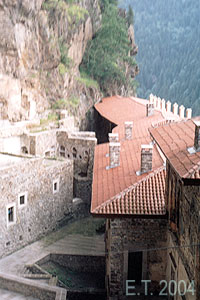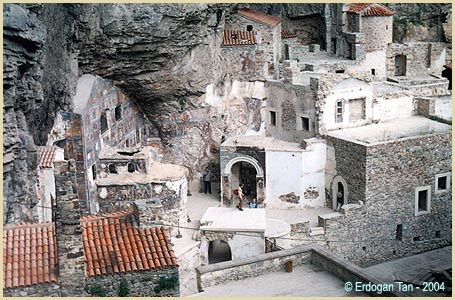| BlackSea Space Images | Road Map | |
|
|
|
|
 |
 |
|
|
INTRODUCTION (The text continues from sumela2.html) The principal elements of the Monastery complex are the Rock Church, several chapels, kitchens, student rooms, a guesthouse, library and sacred spring revered by Orthodox Greeks. There were built over a very large area. The large aqueduct at the entrnace, which cleary supplied water to Monastery, is constructed against the side of the cliff. The aqueduct has many arches which is now mostly restorated. The entrance of the Monastery leads up by a long and narrow stairway. There is a guard-room next to the entrance. The stairs lead from there to the inner courtyard. On the left, in front of the cave, which constitutes the centre of the Monastery and which was turned into a church, there are several Monastery buildings. The library is on the right. The large building which a balcony on the front part of the cliff was used for the monks' cells and guesthouse, it dates to 1860. The influence of Turkish art can be observed in the design of the cupboards, niches and fire-places in the rooms of the buildings surrunding the courtyard. The inner and outer walls of the Rock Church and the walls of the adjacent chapel whch were painted on three levels in three differnet periods are dated to the begining of the 18th century. The frescoes of the bottom band are of superior quality. The frescoes of the Sumela Monastery are seriously damaged since they have largely been moved from their original settings. The main subject of the frescoes are biblical scenes ans scenes telling the story of Christ and the Virgin Mary. |
||
|
SUMELA WEB SITE SECTION - CONTENTS:
|
||